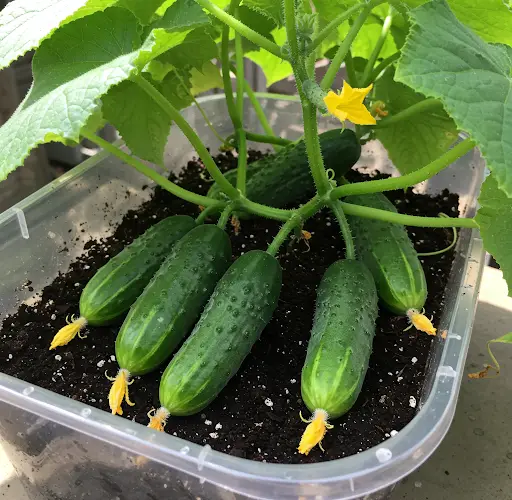How to Grow Cucumbers in Plastic Containers at Home
Growing cucumbers at home is a rewarding experience, especially when you don’t have much outdoor space. With a little creativity, you can successfully grow cucumbers in plastic containers on a balcony, terrace, or even a sunny window. Container gardening is an excellent way to manage space, control pests, and ensure your plants get the right nutrients. Here’s a detailed step-by-step guide to help you grow healthy, productive cucumber plants in plastic containers.
Choosing the Right Cucumber Variety
When growing cucumbers in containers, it’s important to choose the right variety. Look for compact or bush types, as they are better suited for container gardening. Some popular container-friendly varieties include:
-
Bush Champion
-
Spacemaster
-
Patio Snacker
-
Picklebush
These types don’t sprawl as much and are ideal for limited spaces. Vining varieties can also be grown in containers, but they will require vertical support such as a trellis or stake.
Selecting the Right Container
Plastic containers are a great choice for growing cucumbers as they are lightweight, durable, and easy to move around. Select a container that is at least 12-18 inches deep and wide, with a capacity of at least 5 gallons. This will provide enough space for the roots to grow and help retain moisture. Ensure the container has good drainage holes to prevent waterlogging.
You can reuse old paint buckets, large water bottles, or other plastic containers—just make sure they’re clean and safe for gardening use.
Preparing the Soil Mix
Cucumbers thrive in loose, well-draining, and nutrient-rich soil. A good potting mix for cucumbers should contain:
-
40% garden soil or loam
-
30% compost or well-rotted manure
-
20% coco peat or coconut coir
-
10% sand or perlite for drainage
Mix everything thoroughly before filling the container. This combination ensures proper aeration, moisture retention, and a steady supply of nutrients throughout the growing season.
Planting the Seeds
Sow cucumber seeds directly into the container about ½ to 1 inch deep. Place 2 to 3 seeds in the center of the container, spacing them a few inches apart. After germination, thin out the weaker seedlings, keeping the strongest one or two.
Water the soil gently after sowing, keeping it moist but not soaked. Germination typically takes 5 to 10 days, depending on the temperature.
Providing Support
Even compact cucumber varieties may benefit from some form of support. A small trellis, bamboo sticks, or even an inverted tomato cage can guide the vines upward, saving space and improving air circulation. Vertical growth also keeps the fruits clean and easier to harvest.
Watering and Fertilizing
Cucumbers are thirsty plants and need consistent watering. Keep the soil evenly moist, especially during flowering and fruiting. However, avoid overwatering, as soggy soil can lead to root rot.
In terms of feeding, cucumbers are heavy feeders. Apply a balanced liquid fertilizer every 10 to 14 days during the growing season. You can also use organic options like compost tea, fish emulsion, or diluted seaweed extract.
Sunlight Requirements
Cucumbers need full sun to grow well. Place your container where it receives at least 6 to 8 hours of direct sunlight per day. If you’re growing indoors or in a shaded balcony, consider supplementing with grow lights to promote healthy growth and flowering.
Pest and Disease Management
Cucumber plants can be affected by pests such as aphids, spider mites, and whiteflies. Inspect your plants regularly and use natural remedies like neem oil, insecticidal soap, or a garlic spray if infestations occur.
Also, keep an eye out for common diseases like powdery mildew or downy mildew. Proper air circulation, adequate spacing, and watering at the base of the plant (not on the leaves) can help prevent fungal issues.
Harvesting Cucumbers
Depending on the variety, cucumbers are ready to harvest in 50 to 70 days after planting. Pick them when they are firm, uniformly green, and about 6 to 8 inches long (for slicing types). Regular harvesting encourages the plant to produce more fruits.
Avoid leaving cucumbers on the vine too long, as overripe cucumbers can become bitter and reduce the plant’s productivity.
Final Tips
-
Rotate the container periodically if sunlight comes from one direction to ensure even growth.
-
Mulch the soil surface with dry leaves or straw to conserve moisture and prevent weed growth.
-
Avoid overcrowding—each plant needs ample space and airflow.
Growing cucumbers in plastic containers is simple, sustainable, and ideal for urban gardening. With proper care and attention, you can enjoy fresh, crunchy cucumbers from your own home garden all season long.



